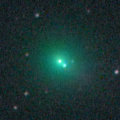
|
Brightening rapidly. Now it is 7.7 mag (May 22, Marco Goiato). It will approach to the sun down to 0.4 A.U. in July, and it is expected to reach up to 2-3 mag. In the Northern Hemisphere, it is observable only until June.
Date(TT) R.A. (2000) Decl. Delta r Elong. m1 Best Time(A, h)
May 22 0 29.99 23 50.5 1.451 1.064 47 7.6 5:23 (224, 16)
May 29 1 3.90 31 2.2 1.311 0.933 45 6.7 5:27 (220, 10)
|
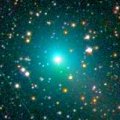
|
Now it is so bright as 7.9 mag (May 5, Juan Jose Gonzalez). It will be observable at 8-9 mag in good condition from April to May. After that, it keeps observable for a long time until when it fades out in the Northern Hemisphere, although it will be low in July.
Date(TT) R.A. (2000) Decl. Delta r Elong. m1 Best Time(A, h)
May 22 3 41.58 82 18.0 1.626 1.457 62 8.8 5:23 (189,-35)
May 29 5 34.14 78 44.5 1.749 1.482 57 9.1 18:26 (167,-32)
|
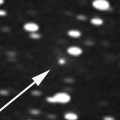
|
Brightening rapidly. It is already so bright as 10.9 mag (May 23, Marco Goiato). It keeps observable bright as 9-10 mag for a long time until autumn.
Date(TT) R.A. (2000) Decl. Delta r Elong. m1 Best Time(A, h)
May 22 21 45.74 -8 41.4 1.017 1.495 94 10.8 5:23 (193, 63)
May 29 22 7.01 -8 6.6 0.962 1.475 96 10.4 5:27 (188, 63)
|
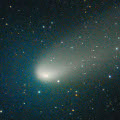
|
It reached up to 9.2 mag in March (Mar. 20, Marco Goiato). Now it is fading, but still bright as 9.7 mag (May 22, Juan Jose Gonzalez). It keeps observable in a good condition for a long time. It keeps observable until autumn when it fades down to 16 mag.
Date(TT) R.A. (2000) Decl. Delta r Elong. m1 Best Time(A, h)
May 22 14 3.02 -5 18.3 0.871 1.816 149 11.1 22:03 (180, 60)
May 29 14 4.41 -5 48.9 0.934 1.847 143 11.4 21:37 (180, 61)
|
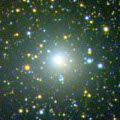
|
It reached up to 7.7 mag in last summer (Aug. 13, Chris Wyatt). It is fading now. It has already faded down to 11.5 mag (May 23, Marco Goiato). In the Southern Hemisphere, it keeps observable for a long time after this. But in the Northern Hemisphere, it is only observable in the low sky in spring, then it will never be observable again.
Date(TT) R.A. (2000) Decl. Delta r Elong. m1 Best Time(A, h)
May 22 19 57.80 -37 16.4 3.677 4.337 124 11.5 4:01 ( 0, 88)
May 29 19 49.34 -38 53.9 3.629 4.380 132 11.5 3:25 ( 0, 86)
|
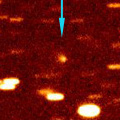
|
It brightened up to 15.5 mag in January (Jan. 31, C. Rinner, F. Kugel). It is not observable now. The condition of this apparition is bad. It will reach up to 11-12 mag from spring to autumn, but it is not observable.
Date(TT) R.A. (2000) Decl. Delta r Elong. m1 Best Time(A, h)
May 22 3 27.80 22 2.2 2.435 1.434 6 12.1 5:23 (252,-14)
May 29 3 52.44 22 33.5 2.411 1.410 7 11.9 5:27 (251,-13)
|

|
Chris Wyatt reported it was visible visually at 11.3 mag on Apr. 25. But no other observations have been reported. The condition of this apparition is very bad. It will never be observable after this.
Date(TT) R.A. (2000) Decl. Delta r Elong. m1 Best Time(A, h)
May 22 2 40.04 19 58.2 1.673 0.769 17 12.5 5:23 (248, -3)
May 29 3 21.22 21 33.7 1.698 0.758 14 12.2 5:27 (248, -6)
|
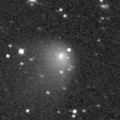
|
Bright new comet discovered as a bright stellar object of 12.5 mag on Apr. 16. It was not detected, fainter than 20 mag, on the previous day (Apr. 15, Catalina Sky Survey). It was discovered just after the sudden outburst. It is bright as 11.3 mag still now (May 22, Juan Jose Gonzalez). The coma is expanding up to 3 arcmin.It keeps observable good condition for a while. The coma will be expanding rapidly after this.
Date(TT) R.A. (2000) Decl. Delta r Elong. m1 Best Time(A, h)
May 22 13 17.76 3 43.4 2.329 3.125 134 12.9 21:18 (180, 51)
May 29 13 15.89 3 10.7 2.399 3.128 128 13.1 20:48 (180, 52)
|

|
Now it is visible visually at 12.3 mag (May 22, Juan Jose Gonzalez). It will brighten up to 12-13 mag in summer. But it locates somewhat low in the Northern Hemisphere.
Date(TT) R.A. (2000) Decl. Delta r Elong. m1 Best Time(A, h)
May 22 21 3.47 -25 41.4 1.962 2.491 109 13.0 5:06 (180, 81)
May 29 21 8.41 -26 5.0 1.894 2.500 115 13.0 4:43 (180, 81)
|
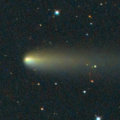
|
It brightened up to 9.5 mag on Jan. 13 (Juan Jose Gonzalez). Now it is fading rapidly. But it is still bright as 12.8 mag (May 17, Juan Jose Gonzalez). It will be observable in good condition for a long time after this in the Northern Hemisphere. It keeps visible visually until summer. In mid March, the nuclear fragmentation was observed.
Date(TT) R.A. (2000) Decl. Delta r Elong. m1 Best Time(A, h)
May 22 14 42.58 63 18.9 3.112 3.359 95 13.0 22:42 (180, -8)
May 29 14 38.48 62 37.1 3.200 3.413 93 13.2 22:10 (180, -8)
|

|
Great outburst up to 11 mag occured on Feb. 2. Another new minor outburst occured up to 12.7 mag on Apr. 16 (Albert Sanchez Caso). It is bright as 11.2 mag still now (May 16, Juan Jose Gonzalez).
Date(TT) R.A. (2000) Decl. Delta r Elong. m1 Best Time(A, h)
May 22 9 22.54 12 45.4 6.336 6.212 78 14.0 18:29 (159, 40)
May 29 9 25.14 12 31.5 6.445 6.213 72 14.0 18:26 (152, 38)
|
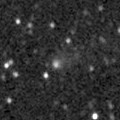
|
Now it is visible visually at 14.3 mag (May 21, Alan Hale). It keeps observable for a long time until September when it becomes fainter than 18 mag.
Date(TT) R.A. (2000) Decl. Delta r Elong. m1 Best Time(A, h)
May 22 16 12.07 -29 5.3 0.741 1.747 170 14.8 0:16 (180, 84)
May 29 16 11.49 -28 14.5 0.753 1.763 172 14.8 23:44 (180, 83)
|
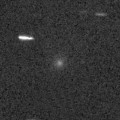
|
Bright new comet discovered at 11 mag in the extremely low sky at dawn. Now it is 10.7 mag (Mar. 27, Juan Jose Gonzalez). It was observed only about one week. It will never be observable again.
Date(TT) R.A. (2000) Decl. Delta r Elong. m1 Best Time(A, h)
May 22 3 59.41 6 57.7 2.082 1.122 13 15.1 18:29 ( 92,-10)
May 29 4 14.91 3 58.1 2.157 1.230 17 15.6 5:27 (270, -7)
|
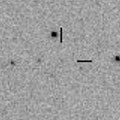
|
It was observed as 15.6 mag at the end of last year (Dec. 6, A. Maury, J. B. de Vanssay, F. Mallia, F. Kugel). It will be 14 mag from winter to spring in 2010. But the condition is bad. It had been unobservable for a while, but it is getting observable in the morning sky now. Then it keeps observable while fading gradually.
Date(TT) R.A. (2000) Decl. Delta r Elong. m1 Best Time(A, h)
May 22 2 7.90 34 9.0 2.804 1.960 27 15.1 5:23 (232, -6)
May 29 2 23.45 36 58.3 2.809 1.996 29 15.2 5:27 (228, -6)
|

|
The condition of this apparition is very bad. It will go away without any observations.
Date(TT) R.A. (2000) Decl. Delta r Elong. m1 Best Time(A, h)
May 22 5 8.87 19 23.8 2.125 1.200 17 15.1 18:29 (112, -3)
May 29 5 37.43 19 17.9 2.145 1.219 17 15.3 18:26 (112, -2)
|
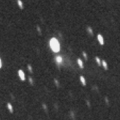
|
Now it is 15.5 mag (Feb. 20, S. Plaksa, E. Bryssinck). It is also visible visually at 14.5 mag (Apr. 10, Juan Jose Gonzalez). It keeps observable at 15 mag for a long time in 2010.
Date(TT) R.A. (2000) Decl. Delta r Elong. m1 Best Time(A, h)
May 22 17 59.68 37 6.8 4.107 4.633 115 15.2 2:03 (180, 18)
May 29 17 56.83 38 21.8 4.083 4.620 116 15.2 1:32 (180, 17)
|
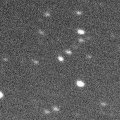
|
Now it is 15.5 mag (May 14, Richard Brown). It keeps bright as 14-15 mag for a long time after this until 2013. It is observable in good condition in the Southern Hemisphere. However, it is not observable in the Northern Hemisphere.
Date(TT) R.A. (2000) Decl. Delta r Elong. m1 Best Time(A, h)
May 22 15 6.52 -48 9.8 6.013 6.912 150 15.3 23:06 ( 0, 77)
May 29 14 59.73 -48 18.8 5.998 6.882 148 15.3 22:32 ( 0, 77)
|

|
It passes the perihelion in August. But the condition of this apparition is bad. It is not observable in the Northern Hemisphere. In the Southern Hemisphere, it appears in the evening sky at 9 mag in late August, then it will keep observable while fading rapidly.
Date(TT) R.A. (2000) Decl. Delta r Elong. m1 Best Time(A, h)
May 22 2 23.72 20 26.3 2.408 1.509 21 16.2 5:23 (245, -1)
May 29 2 43.26 22 3.0 2.290 1.413 22 15.4 5:27 (242, 1)
|
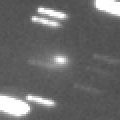
|
It became bright more rapidly than expected. Now it is 14.8 mag (Apr. 6, Catalina Sky Survey). It keeps 15 mag for a while. But it will be getting lower gradually in the evening sky.
Date(TT) R.A. (2000) Decl. Delta r Elong. m1 Best Time(A, h)
May 22 7 25.20 33 2.1 2.211 1.714 48 15.4 18:29 (143, 10)
May 29 7 48.77 32 19.1 2.270 1.741 46 15.4 18:26 (142, 10)
|

|
Now it is 15.3 mag (Mar. 26, P. Concari, S. Foglia, G. Galli, M. Tombelli). It was observed as 15-16 mag in early 2009. In 2010, it will be observable at 16 mag in good condition from winter to spring.
Date(TT) R.A. (2000) Decl. Delta r Elong. m1 Best Time(A, h)
May 22 13 21.11 -1 46.1 2.881 3.699 138 15.7 21:21 (180, 57)
May 29 13 19.31 -1 51.5 2.957 3.705 131 15.7 20:52 (180, 57)
|
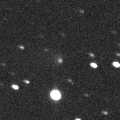
|
Now it is 15.2 mag (May 12, Hidetaka Sato). It will be observable at 13-14 mag for a long time from 2011 to 2012. In 2010, it is observable at 15-16 mag in good condition from spring to autumn.
Date(TT) R.A. (2000) Decl. Delta r Elong. m1 Best Time(A, h)
May 22 21 57.49 1 59.6 7.195 7.240 88 15.7 5:23 (195, 52)
May 29 21 55.57 2 6.1 7.038 7.206 95 15.7 5:27 (181, 53)
|
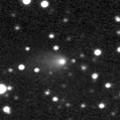
|
It became visible visually at 13.3 mag in winter (Feb. 3, Marco Goiato). Now it is fading slowly, but still bright as 15.2 mag (May 21, Catalina Sky Survey). It will be getting lower in the evening sky after this. It will be too low to observe in July.
Date(TT) R.A. (2000) Decl. Delta r Elong. m1 Best Time(A, h)
May 22 8 13.43 23 18.2 2.203 1.906 59 15.9 18:29 (146, 24)
May 29 8 30.94 22 36.4 2.266 1.916 57 15.9 18:26 (144, 23)
|

|
It reached up to 15.0 mag in March (Mar. 8, D. Storey). Now it is fading. It has already faded down to 16.2 mag (May 4, L. Elenin, S. Plaksa, D. Chestnov, A. Novichonok). It will be too low to observe in July at 17 mag.
Date(TT) R.A. (2000) Decl. Delta r Elong. m1 Best Time(A, h)
May 22 10 39.30 15 45.3 1.950 2.270 94 16.1 18:40 (180, 39)
May 29 10 47.56 14 33.0 2.034 2.278 90 16.3 18:26 (178, 41)
|
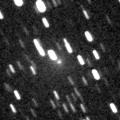
|
Now it is 14.1 mag (May 5, Hidetaka Sato), much brighter than this ephemeris. It has a very faint large coma.
Date(TT) R.A. (2000) Decl. Delta r Elong. m1 Best Time(A, h)
May 22 10 48.32 57 49.2 1.520 1.671 79 16.1 18:50 (180, -2)
May 29 11 10.59 52 6.5 1.578 1.724 80 16.4 18:45 (180, 3)
|
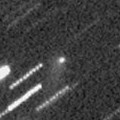
|
It was bright as 15 mag in early May at the discovery. But it is fading rapidly. It has already faded down to 16.3 mag (May 24, Catalina Sky Survey). It will be fainter than 18 mag in late June.
Date(TT) R.A. (2000) Decl. Delta r Elong. m1 Best Time(A, h)
May 22 15 37.29 17 51.1 1.272 2.159 141 16.4 23:34 (180, 37)
May 29 15 7.01 20 55.9 1.387 2.212 133 16.7 22:37 (180, 34)
|

|
It brightened up to 11 mag in spring and summer in 2009. Appearing in the morninig sky again. Now it is 16.4 mag (May 1, Ken-ichi Kadota). It keeps observable after this until autumn when it becomes fainter than 18 mag while fading gradually. But it locates somewhat low in the Northern Hemisphere.
Date(TT) R.A. (2000) Decl. Delta r Elong. m1 Best Time(A, h)
May 22 20 12.79 -24 38.0 2.308 2.954 120 16.5 4:16 (180, 80)
May 29 20 12.33 -24 49.6 2.254 2.980 127 16.5 3:48 (180, 80)
|

|
It brightened up to 13 mag and observed visually from 2007 to 2009. Due to the far distance, it is bright as 14.8 mag still now (Apr. 7, E. Bryssinck, A. Novichonok, D. Chestnov, L. Elenin). It will be getting lower in the evening sky after this, and it will be too low to observe in August. However, it will be observable in good condition again at 17.5 mag in autumn.
Date(TT) R.A. (2000) Decl. Delta r Elong. m1 Best Time(A, h)
May 22 11 47.05 42 1.0 8.033 8.194 95 16.7 19:47 (180, 13)
May 29 11 43.75 41 37.2 8.167 8.228 89 16.7 19:16 (180, 13)
|

|
Now it is 17.2 mag (May 16, Ken-ichi Kadota). It keeps 17 mag for a while after this.
Date(TT) R.A. (2000) Decl. Delta r Elong. m1 Best Time(A, h)
May 22 15 29.95 -1 26.1 1.629 2.604 160 17.0 23:29 (180, 56)
May 29 15 26.20 -1 47.7 1.625 2.584 155 17.0 22:58 (180, 57)
|

|
Now it is 18.8 mag (May 16, J. F. Hernandez). This apparition is best condition. It will approach to the earth down to 0.12 A.U. in October, and brighten up to 5 mag. It will be visible with naked eyes. In the Northern Hemisphere, it keeps observable all through this apparition until 2011 June when it fades down to 17 mag.
Date(TT) R.A. (2000) Decl. Delta r Elong. m1 Best Time(A, h)
May 22 21 22.08 1 20.4 1.828 2.196 97 17.5 5:23 (180, 54)
May 29 21 30.20 3 1.0 1.696 2.135 100 17.1 5:05 (180, 52)
|
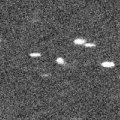
|
Now it is 17.8 mag (May 17, Catalina Sky Survey). It will reach up to 17 mag in spring and summer.
Date(TT) R.A. (2000) Decl. Delta r Elong. m1 Best Time(A, h)
May 22 21 9.37 -7 19.4 3.018 3.392 102 17.2 5:12 (180, 62)
May 29 21 10.43 -8 37.3 2.932 3.411 109 17.2 4:46 (180, 64)
|
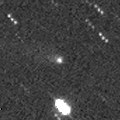
|
Now it is 17.1 mag (May 12, Catalina Sky Survey). It keeps observable in good condition for a while, but it will be fading after this. It will be fainter than 18 mag in July.
Date(TT) R.A. (2000) Decl. Delta r Elong. m1 Best Time(A, h)
May 22 12 1.03 22 52.1 3.215 3.666 108 17.2 20:01 (180, 32)
May 29 11 54.03 21 28.8 3.370 3.710 101 17.3 19:26 (180, 34)
|

|
Now it is 17.2 mag (May 19, Hidetaka Sato). It will be observable at 17 mag in good condition in summer.
Date(TT) R.A. (2000) Decl. Delta r Elong. m1 Best Time(A, h)
May 22 21 59.15 -10 42.9 3.193 3.392 92 17.3 5:23 (202, 64)
May 29 21 52.72 -9 43.5 3.058 3.390 100 17.2 5:27 (180, 65)
|
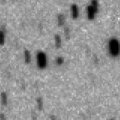
|
Now it is 17.2 mag (Apr. 10, Hidetaka Sato). It was observed at 17.5 mag in 2009 spring. It will be observable at 17.5 mag again in 2010 spring. However, it locates low in the Northern Hemisphere.
Date(TT) R.A. (2000) Decl. Delta r Elong. m1 Best Time(A, h)
May 22 13 26.80 -15 6.0 5.169 6.023 144 17.4 21:27 (180, 70)
May 29 13 25.48 -14 12.1 5.248 6.034 137 17.4 20:58 (180, 69)
|
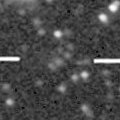
|
Now it is 17.3 mag (Jan. 23, Ken-ichi Kadota). It keeps observable at 17.5 mag in good condition for a long time in 2010.
Date(TT) R.A. (2000) Decl. Delta r Elong. m1 Best Time(A, h)
May 22 23 5.91 81 6.8 5.148 4.847 67 17.4 5:23 (184,-27)
May 29 22 48.23 82 37.1 5.140 4.849 67 17.4 5:27 (182,-28)
|
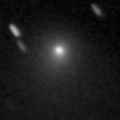
|
Now it is 17.4 mag (Feb. 17, Hidetaka Sato). It will be fainter than 18 mag in July.
Date(TT) R.A. (2000) Decl. Delta r Elong. m1 Best Time(A, h)
May 22 18 55.89 41 43.9 6.525 6.859 105 17.6 2:59 (180, 13)
May 29 18 53.25 42 17.9 6.540 6.909 107 17.6 2:29 (180, 13)
|

|
Now it is 17.8 mag (May 14, Hiroshi Abe). It keeps observable at 17-18 mag for a long time until 2011 summer.
Date(TT) R.A. (2000) Decl. Delta r Elong. m1 Best Time(A, h)
May 22 20 55.77 4 32.8 3.998 4.324 101 18.0 4:59 (180, 50)
May 29 20 49.76 5 41.0 3.859 4.299 109 17.9 4:25 (180, 49)
|
|
![]()
 P/2010 H2 ( Vales )
P/2010 H2 ( Vales ) 65P/Gunn
65P/Gunn C/2007 Q3 ( Siding Spring )
C/2007 Q3 ( Siding Spring ) 29P/Schwassmann-Wachmann 1
29P/Schwassmann-Wachmann 1 P/2010 A5 ( LINEAR )
P/2010 A5 ( LINEAR ) C/2010 F4 ( Machholz )
C/2010 F4 ( Machholz ) 126P/IRAS
126P/IRAS 104P/Kowal 2
104P/Kowal 2 C/2008 FK75 ( Lemmon-Siding Spring )
C/2008 FK75 ( Lemmon-Siding Spring ) C/2009 F4 ( McNaught )
C/2009 F4 ( McNaught ) 2P/Encke
2P/Encke P/2010 A3 ( Hill )
P/2010 A3 ( Hill ) 74P/Smirnova-Chernykh
74P/Smirnova-Chernykh C/2006 S3 ( LONEOS )
C/2006 S3 ( LONEOS ) 30P/Reinmuth 1
30P/Reinmuth 1 94P/Russell 4
94P/Russell 4 C/2009 U3 ( Hill )
C/2009 U3 ( Hill ) C/2010 J1 ( Boattini )
C/2010 J1 ( Boattini ) 116P/Wild 4
116P/Wild 4 C/2005 L3 ( McNaught )
C/2005 L3 ( McNaught ) P/2010 J3 ( McMillan )
P/2010 J3 ( McMillan ) 103P/Hartley 2
103P/Hartley 2 C/2009 K2 ( Catalina )
C/2009 K2 ( Catalina ) C/2008 N1 ( Holmes )
C/2008 N1 ( Holmes ) C/2010 J2 ( McNaught )
C/2010 J2 ( McNaught ) C/2009 F2 ( McNaught )
C/2009 F2 ( McNaught ) C/2007 VO53 ( Spacewatch )
C/2007 VO53 ( Spacewatch ) C/2006 Q1 ( McNaught )
C/2006 Q1 ( McNaught ) C/2009 UG89 ( Lemmon )
C/2009 UG89 ( Lemmon )![]()




























